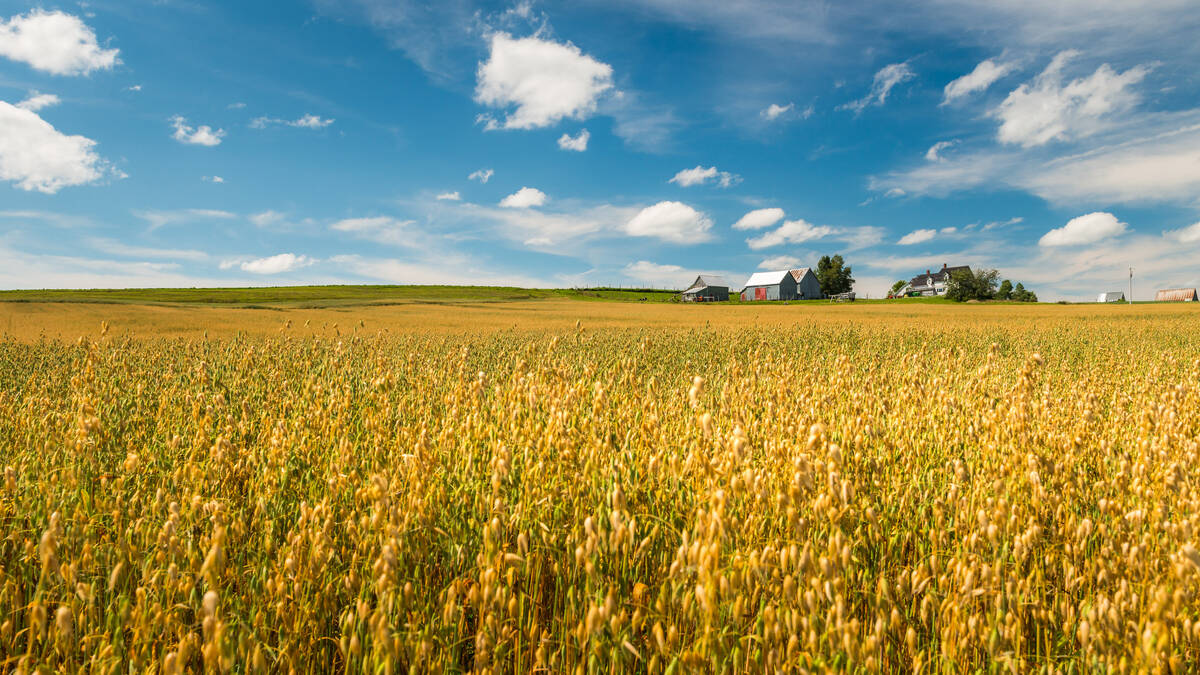Canada may have been the world’s leading exporter of wheat through the 1920s but to anyone farming in the West today, that seems like a very, very long time ago. We have almost forgotten that for decades, wheat was the reason we called the Prairies the breadbasket of the world. Or that around the globe, Canada was symbolized by a head of wheat at least as much as by a maple leaf.
Today, Canada’s share of the global wheat market is under 15 per cent, and it’s still falling. In terms of acreage, our wheat crop has plummeted to eighth place, barely ahead of Afghanistan.
Read Also

Risk management for the farm means considering people, too
Wheat fields in New Brunswick, Canada.
It’s time to ask, what happened to wheat? The obvious answer is that Western Canada’s
farmers simply aren’t planting as many acres of wheat as they used to. But as always on the farm, it’s also more complicated than that.
The news isn’t all bad, points out Brian Oleson, economist at the University of Manitoba who says farmers are planting less wheat because they’re making more money planting other crops.
“The relative return to wheat is lagging behind other crops grown in Canada,” Oleson says. “Research into corn, soybeans and canola has made these crops much more profitable than growing wheat.”
Plus, says Bruce Burnett, director of market analysis for the Canadian Wheat Board, the loss of wheat may not be as severe as you’d think by looking at acreage numbers. While wheat acreage is down significantly from the mid-1990s, actual production hasn’t dropped off nearly as much.
“Western Canadian farmers are maintaining production levels through improvements in productivity and efficiency,” Burnett says.
Yet to many farmers, the loss of wheat leaves a gap. “We need to grow wheat,” says Kevin Bender, president of the Western Canadian Wheat Growers. “Wheat is needed to feed the growing world population. And wheat is an important rotational crop we need to grow to battle diseases in pulses and oilseeds.”
We aren’t alone
Canadian farmers aren’t the only ones cutting their wheat acres. Even the U.S., which is the largest wheat exporter in the world and has shipped an average 28.5 million tons of wheat annually over the last three years, has seen a steady trend to lower wheat plantings over the last 25 years.
In 2006, four worried national wheat organizations launched a study to find out why, and their paper “Addressing the Competitiveness Crisis in Wheat” traced a clear story. “North Dakota wheat plantings have declined 19 per cent in five years and 29 per cent in the last 10 years,” the study says. “Further, Kansas — the Wheat State — produced 18 per cent more corn than wheat last year.”
USDA stats show that wheat’s contribution to field-crop receipts in the U.S. dropped from 20 per cent in the ’80s to just 11 per cent in the past decade.
Dana Peterson, CEO of the National Association of Wheat Growers attributes the decline in wheat acres in the U.S. to the uncompetitiveness of wheat. Peterson sums it up in just a few words: “Farmers grow the crops that are the most profitable.
“Farmers now have more cropping options,” Peterson explains. “New technology and management practices have enabled wheat farmers to grow other, diverse crops.”
Even subsidized European wheat farmers have seen a decrease in their wheat exports. The Food and Agriculture Organization (FAO) reports that EU exports of wheat and flour fell three per cent from 1995 to 2005.
In fact, wheat acres seem to be down in every traditional wheat-producing region. Daniel O’Brien at Kansas State University has even put a number on it. Global harvested wheat acres, says O’Brien, have dropped an average one million acres a year since 1987.
The new breadbaskets
“Economic principles are prompting a change in where wheat is grown in the world,” O’Brien says. “Wheat production is gravitating to areas that have a competitive advantage.”
That advantage includes proximity to markets, as well as agronomic considerations such as soil type, climate, and land cost.
In the U.S. meanwhile, it isn’t that American farmers have lost the fight against other regions. It’s that wheat simply doesn’t pay as much as corn for ethanol and soybeans for export.
O’Brien’s April 2010 analysis, World Wheat Market Supply-Demand Trends highlights this change and provides an overview of the wheat industry that exposes the competitive pressure Canadian wheat producers are facing.
Based on a three-year average, Canada now ranks eighth in the world in harvested wheat acreage with barely more acres than Pakistan, which few Canadians likely consider a wheat-growing nation. See Table One.
Based on these numbers, it’s no wonder that world wheat markets reacted so strongly to drought in Russia last summer.
Nor can Canada’s wheat industry rescue its pride by pointing at its productivity. There, Canada also falls short. The world’s most productive wheat farmers are in the EU with an average 76.9 bushels per acre. Their production is also increasing by about 1.0 bushels per acre every year.
China ranks second in productivity with yields of 65 bushels per acre, but its yields are growing even faster. Thanks to huge investments in agriculture, Chinese farmers are pushing their yields up by an average 2.2 bushels per year.
Meanwhile, the U.S. average is only 41.6 bushels per acre, and is increasing by 1.0 bu./ac. year. Canada’s productivity is slightly lower.
Where wheat still shines
As an exporter, Canada fares better. The U.S. is the No. 1 exporter, shipping 50 per cent of its production. Second is the EU at 19.1 million tonnes (14 per cent of production).
Canada is third, and due to its small population and low domestic use, we export an average 70 per cent of our wheat. Over the last three years, that’s meant annual exports of 17.6 million tonnes.
However, Russia is poised to overtake Canada, having exported an average of 16.1 million tonnes in the last three years, just over a quarter of its production. Some USDA projections suggest Russia, Kazakhstan, and Ukraine could increase their wheat exports to 50 million tonnes by 2019, surpassing all other wheat-growing areas and becoming the new breadbasket of the world.
More important to a wheat-exporting nation like Canada is determining which countries are buying. Who are our potential customers? The rankings of the top six importing regions between 2007-10 were, North Africa, the Middle East, Sub-Saharan Africa, South America, Southeast Asia, and East Asia.
The University of Manitoba’s Oleson points out that in the 1980s about half of Canada’s wheat exports went to China and the former Soviet Union (FSU). Today, the FSU is a major wheat exporter and imports only when weather losses reduce yield.
China has substantially grown its wheat production capacity, so wheat exports to China have fallen dramatically. FAO figures show wheat has dropped from being the No. 1 agriculture commodity imported into China in the early ’80s to No. 19 in 2008.
Canola is the new wheat
The wheat board’s Burnett points out that 15 years ago, annual world wheat trade was between 90 million and 100 million tonnes. Today that trade has grown to 110 million to 120 million tonnes.
That might seem healthy growth, yet in the same 15 years, world oilseed trade has nearly tripled, shooting from 35 million up to 109 million tonnes. “And that is just the raw oilseed trade. It doesn’t include processed vegetable oils,” Burnett says. “World raw oilseed trade is now approaching the world trade in wheat.”
In other words, Canadian farmers have secured a significant portion of the world agricultural trade, but by growing canola for the oilseed market instead of growing wheat.
Can wheat get back on track?
Not surprisingly, there are as many opinions about how to bring wheat back as there are farmers who have grown the crop, and their ideas about what changes are needed range from tinkering to restructuring.
Western Canadian Wheat Growers president Kevin Bender says for wheat acreage to recover and grow two actions are essential. “There needs to be an open market in wheat,” Bender says. “Marketing freedom would lead to greater profitability.”
Second, Bender sees the need for more research to increase productivity. According to Bender, work needs to be done that focuses on end-use traits which would add value to wheat. He suggests research is needed into hybridization of wheat. And he says research into biotech wheat is needed to address problems like fusarium, ergot, and drought tolerance.
“Import restrictions on biotech crops are relaxing,” Bender says. “If we don’t adopt biotech crops, our competitors will, and they will be able to produce wheat cheaper than we can.”
Meanwhile, Oleson thinks the trend of smaller wheat crops in Canada is flattening out and he feels there will be a resurgence in wheat because it is a great rotation crop, it is easy to grow, and world population growth will drive demand higher.
Production in many of the new wheat-exporting regions tends to be much more unstable, Oleson says, so Canada has an edge in dependability both of supply and quality. Increasingly, he says, the market will move toward higher-quality wheat.
“Canada faces a number of disadvantages in wheat production,” Burnett adds. “We are long distances to markets and have high transportation costs.
“To regain market share, controlling costs is important,” Burnett says. “The entire system has to be more productive and very efficient. The good news is wheat isn’t decreasing in importance, it is increasing.”CG















